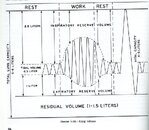Couple of reasons.
1. Stronger lungs
2. Better mental self control
3. Certain classes call for breath holds to pass. Why not be the best?
4. Freediving sounds like fun when scuba is not an option. (Not sure when that is but)
Okay, let me address each of these individually.
1. Stronger lungs
Lungs don't get stronger, but you knowledge of breathing, and the breathing cycles, does. Many divers are no longer taught about how we breathe. They don't know basic anatomy and physiology of breathing. For instance, do you know the terms "residual volume," "tidal volume," or Vital Capacity" concerning lungs? Below is a diagram of this from the U.S. Navy Diving Manual, March 1970. Note that the lungs have a "expiratory reserve volume of some 2-2.5 liters, which is the amount of air that you would have if you exhaled through a scuba regulator and it stopped cold functioning and you could not inhale. There is still air there.
This diagram is important as what the training for breath-holding gives is a knowledge of the entire vital capacity of the lungs, some 4-5 liters of air. So knowledge of the physiology of breathing is pretty vital in addressing anxiety about a regulator malfunction. Over time, vital capacity can be increased, but not over a period of 14 days as one video that was there (and has been pulled) suggested.
2. More mental self control
Once you gain a better understanding of breath control, and the lung's ability to hold air, you can do a lot of different things. In 1975 I was diving on a subtidal clam bed research project for the Oregon Department of Fish and Wildlife, and ran out of air on the second dive at about 30 feet depth. Rather than surface, I was able to get a few breaths buddy breathing from two members of the research team, and finish shooting photos of the project. It took another about 5-7 minutes of buddy breathing a few breaths, and backing away to shoot a photo, then coming back. But that happened, and I was none the worse for it. After running out of film, I simply did a CESA.
3. Certain classes call for breath holds to pass. Why not be the best?
This implies competition, and competition in underwater swimming, unless very closely supervised, can be deadly. I know, as I suffered shallow water blackout after a swim team competition in underwater swimming. I'll detail it later.
4. Freediving sounds like fun when scuba is not an option.
It is, but it is also more dangerous. You don't have breathing gas, and unless you know what you are doing, and have a good buddy nearby, free diving can be deadly. I've come closer to "buying the farm" free diving than scuba diving.
SeaRat





